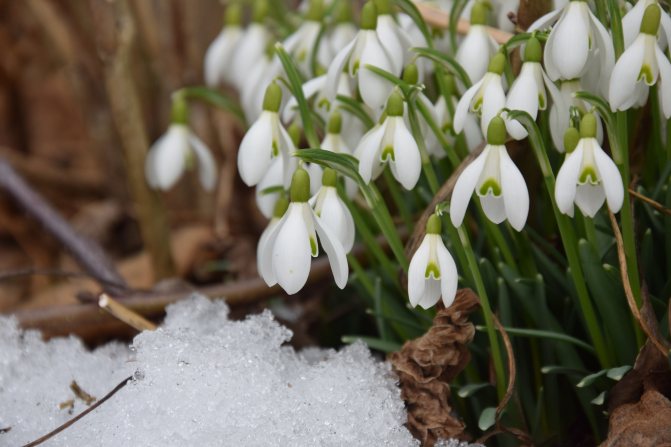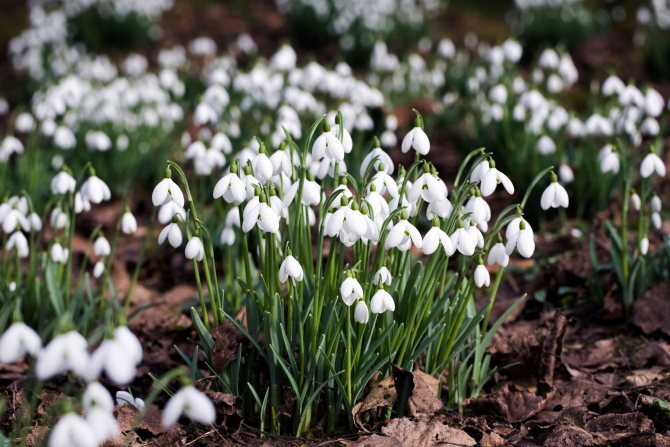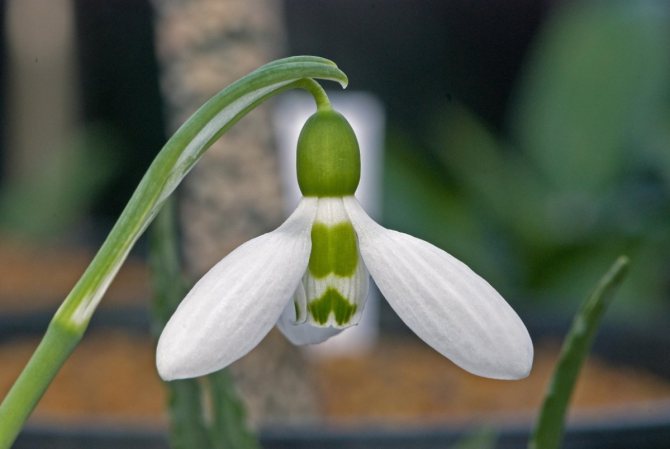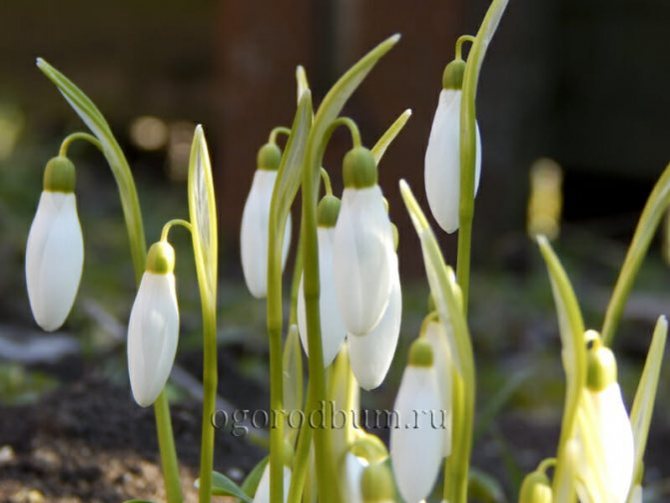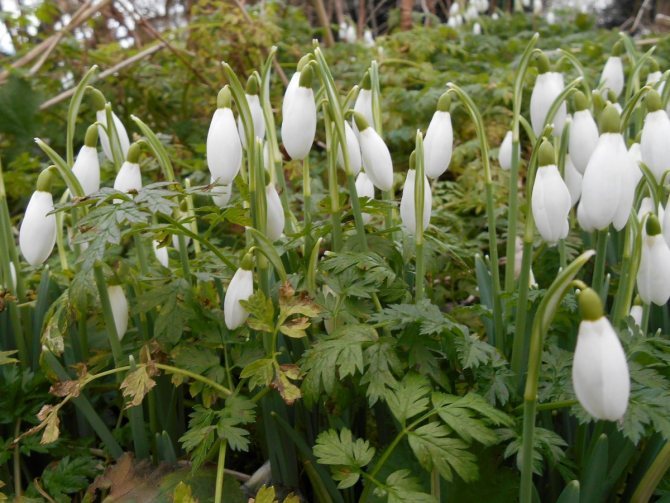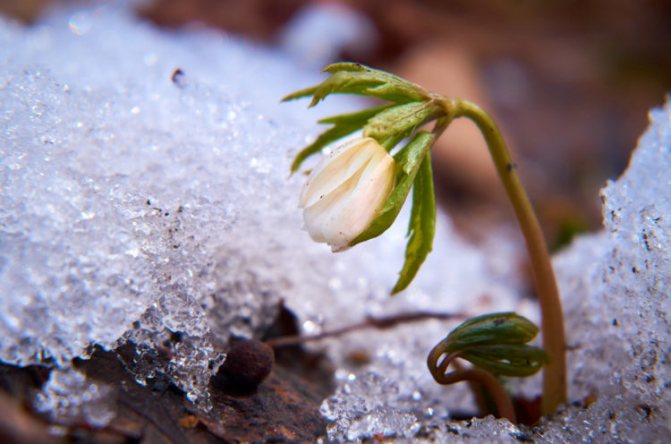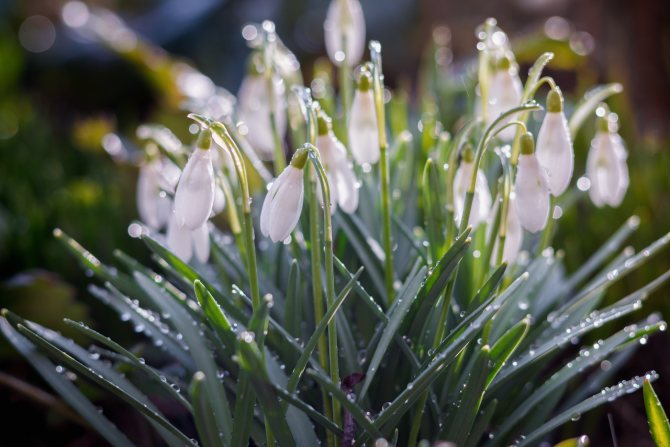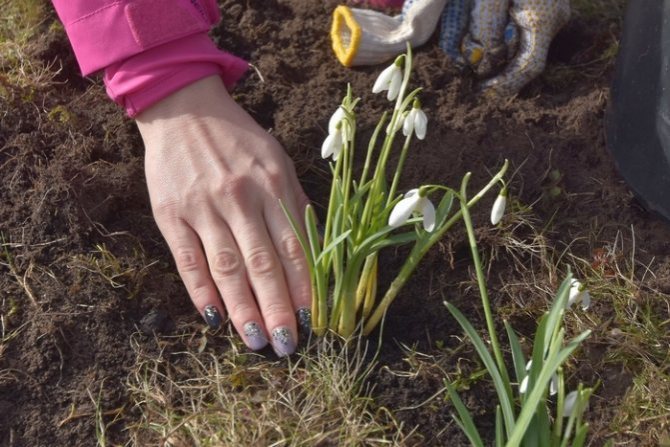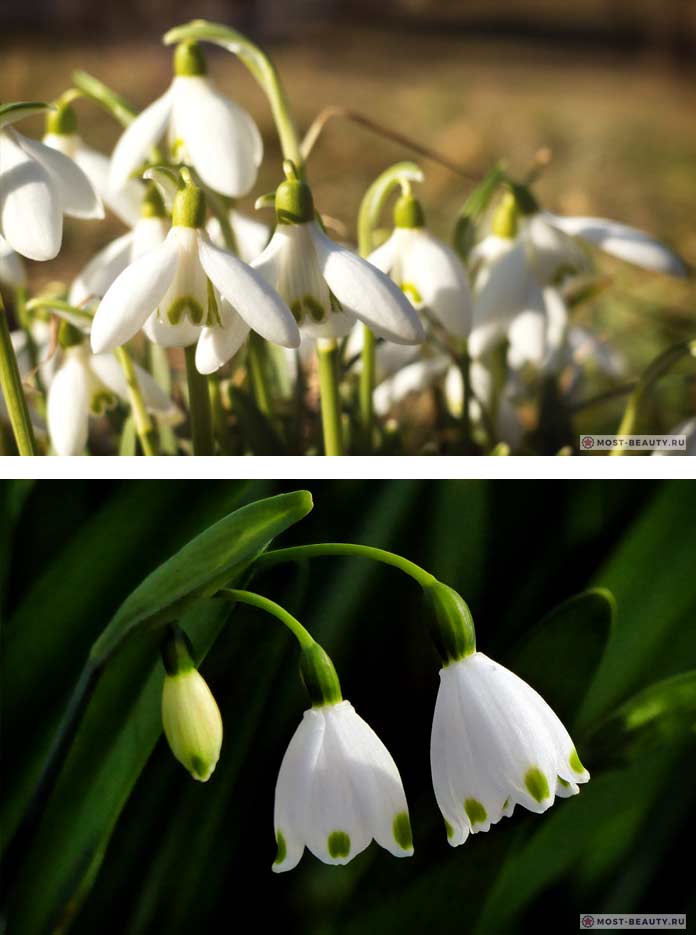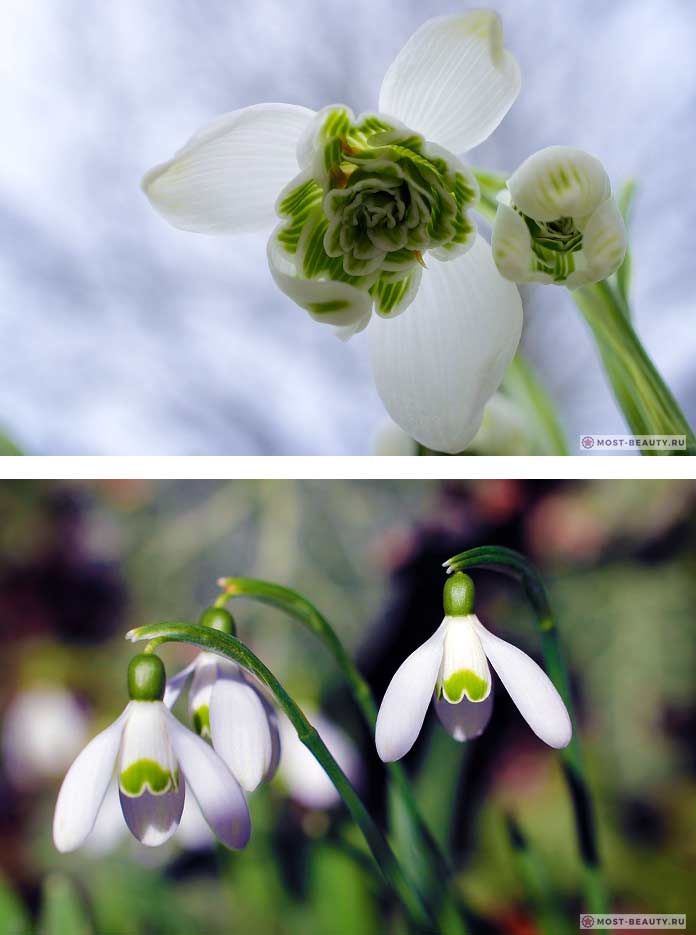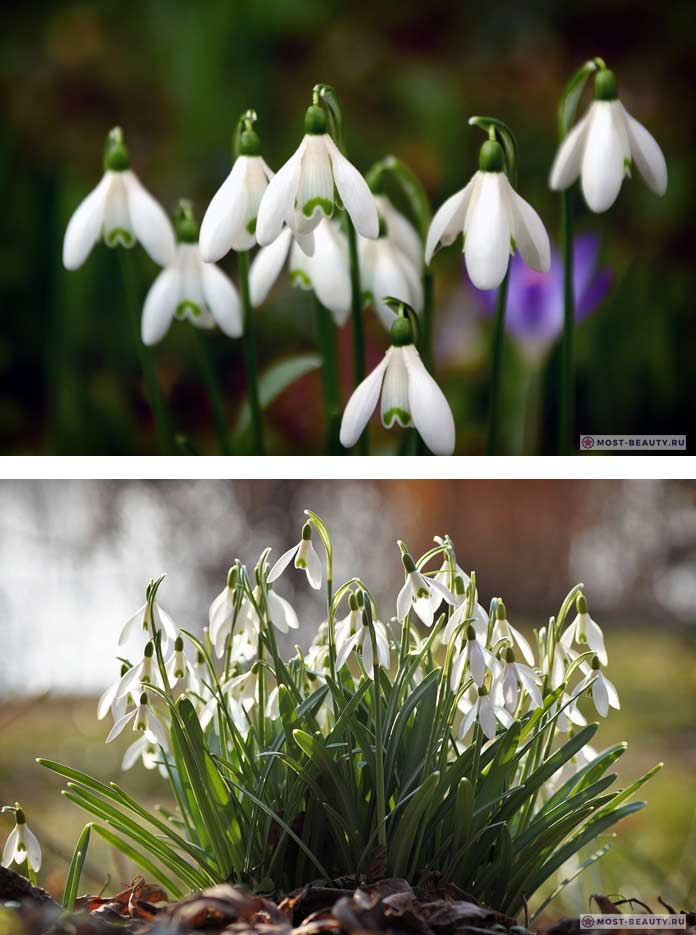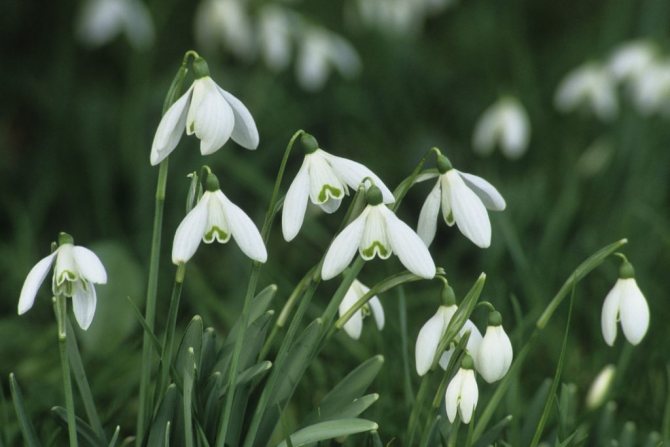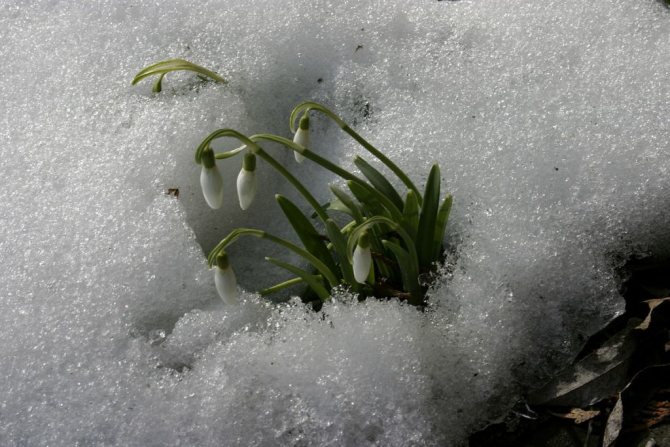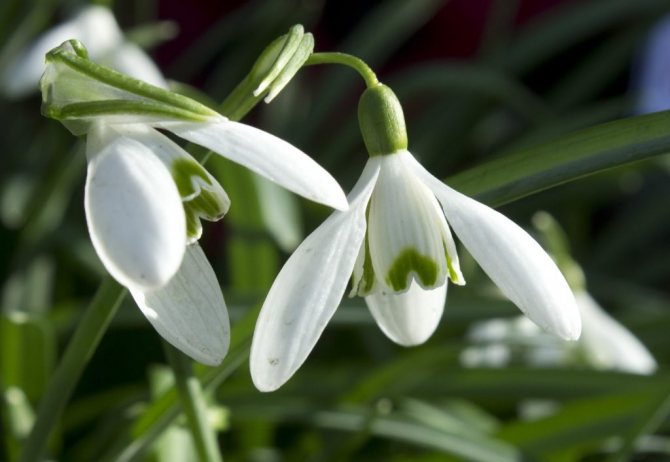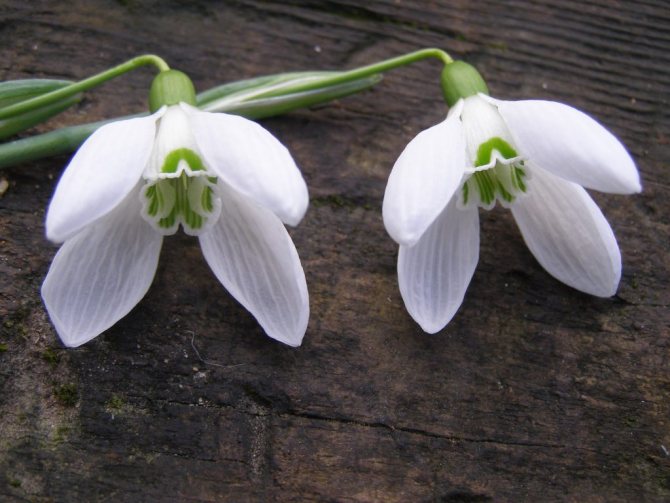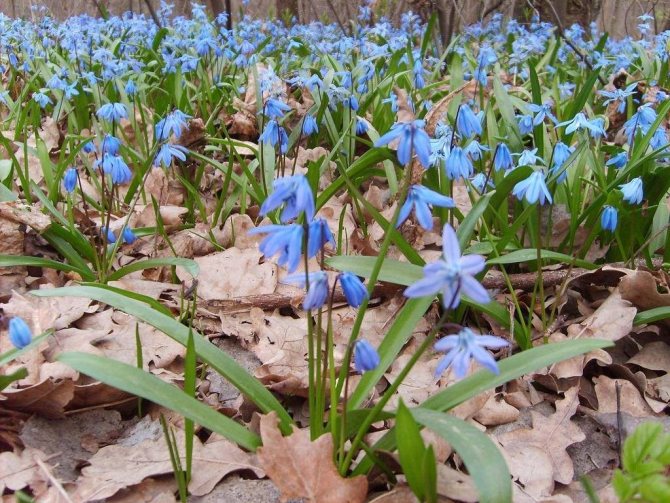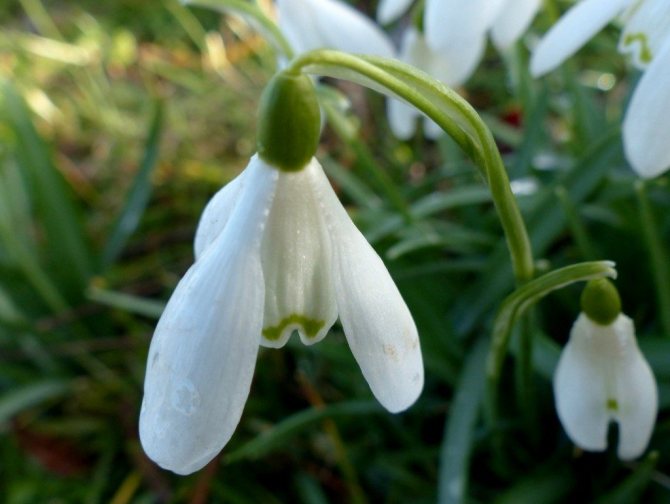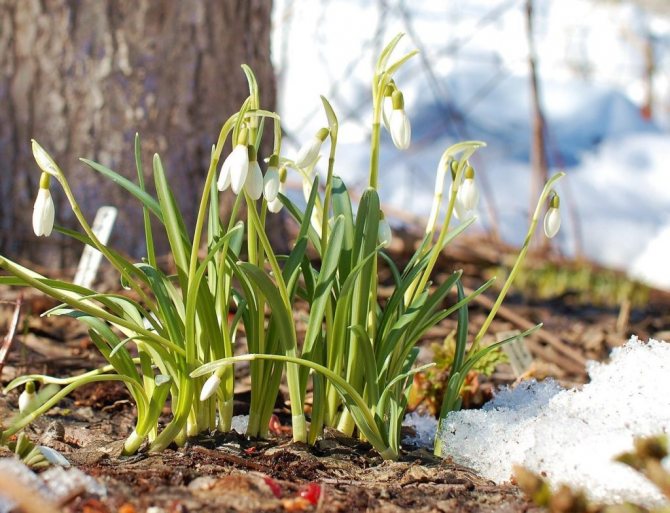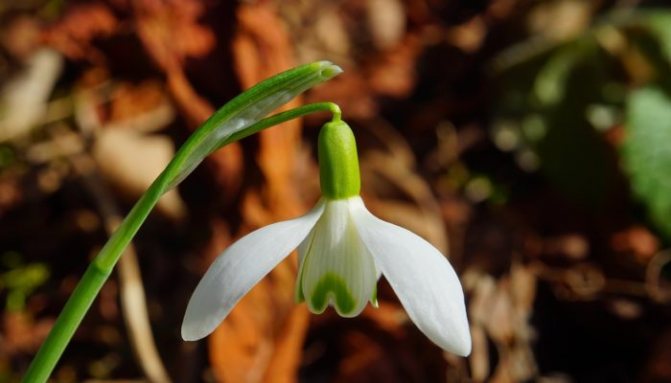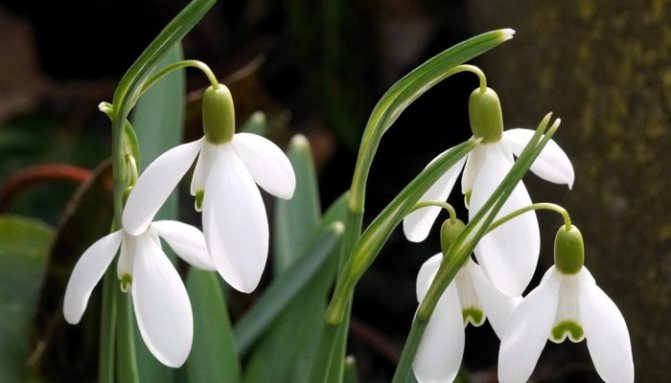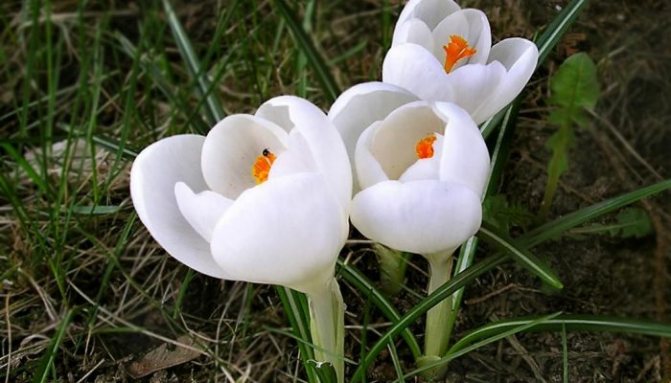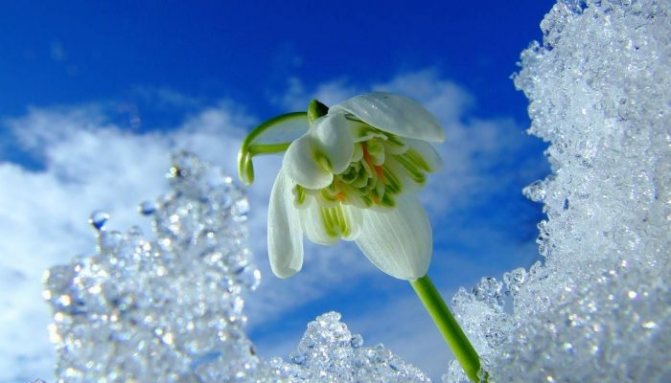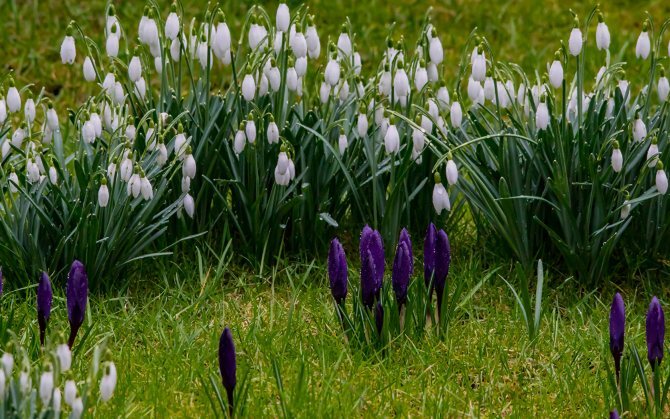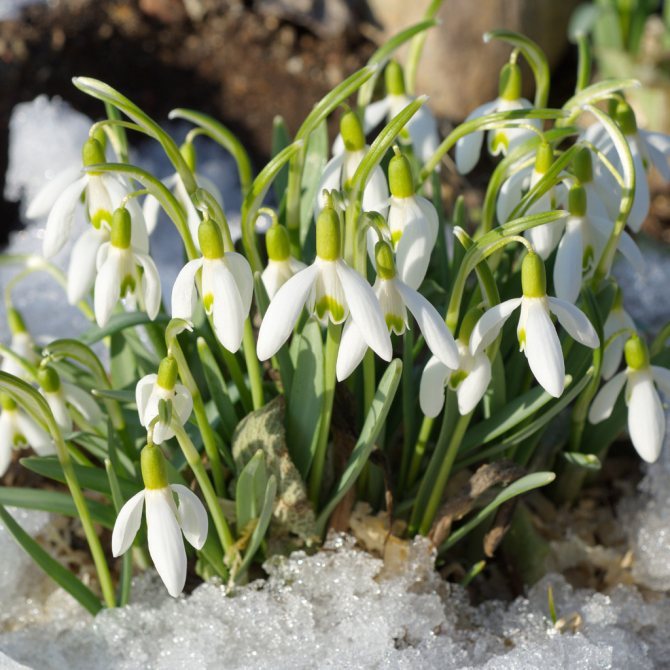Alpine snowdrop
Alpine snowdrop (Galanthus alpinus) — herbaceous bulbous plant, the length of the bulb is 25-35 mm, and the diameter is 15-20 mm. Broad-lanceolate leaves of a dark green color, up to 7 cm long, although after flowering they can grow up to 20 cm.The peduncle reaches a length of 7-9 cm, the outer periflower leaves are obovate, slightly concave, up to 20 mm wide, and up to 10 mm long, the inner ones are half the size, wedge-shaped, with a depression surrounded by a greenish spot.
The plant begins to bloom 4 years after planting. It blooms in late winter and early spring with white flowers, in addition, in late spring, a fruit with small seeds appears. Reproduction is possible both by seed and vegetative - with the help of baby bulbs, which are formed in an adult plant. The homeland of the Alpine snowdrop is the lower and alpine belt, as well as Western Transcaucasia.
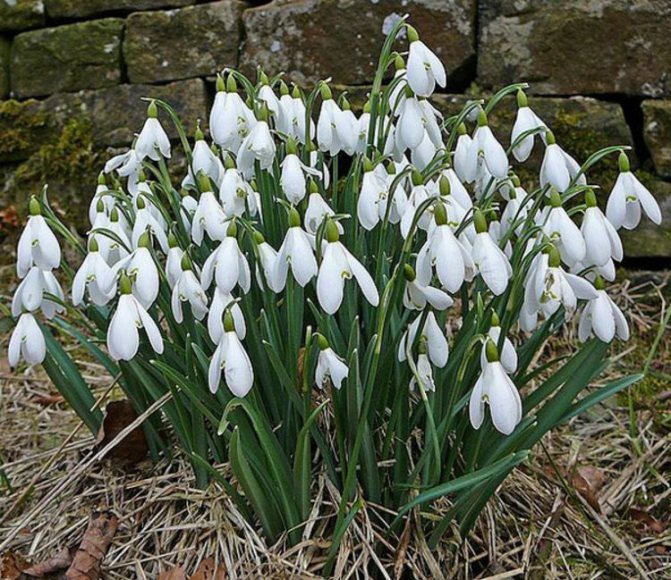
Landing rules
For planting snowdrop it is recommended to choose open sunny areas, or a little shaded... If the plant is planted in the shade, the snow will not melt as quickly as in the sun, as a result of which the flowering will be belated and not as decorative.
The soil for planting will require a loose, nutrient-rich, and also with good water permeability. Snowdrop does not tolerate stagnation of moisture in the ground. The soil must include humus or compost.
Watering is needed only at the stage of germination of seeds or bulbs, in the future, you need to water the culture sparingly, only as needed.
Fertilizers are applied only at the stage of active growth. Snowdrops need elements such as phosphorus and potassium.
It is not necessary to apply fertilizer with a high nitrogen content, this can provoke the development of the fungus.
The flower does not need shelter for the winterlike other plant varieties.


For planting, open sunny areas are needed, the soil should include humus or compost
Byzantine snowdrop
Byzantine snowdrop (Galanthus byzantinus) grows on the Asian coast of the Bosphorus. Florists love to grow it in Western Europe, although in our country this species has not yet become widespread. Prefers turfed open areas. The Byzantine snowdrop is the closest variety of folded.
Its flowering period falls in autumn: first, a low peduncle appears with a green speck at the base of the inner perianth leaves. The appearance of the snowdrop is unusual: a white carved flower with many long petals. Leaves are green, narrow, about 5-6 cm long, erect.


Snowdrop Caucasian
Caucasian snowdrop (Galanthus caucasicus) — plant with linear flat shiny green leaves, reaching a length of 25 cm. The bulb is yellowish, up to 40 mm long, up to 25 mm in diameter. Peduncle 6-10 cm high produces a white fragrant flower 20-25 mm long and about 15 mm in diameter.
The perianth segments on the inner side are partially green. Flowering occurs from the end of March and lasts 12-15 days. Fruiting is irregular, and shelter is required for wintering. In the Caucasian snowdrop, the habitat is more concentrated in the Central Transcaucasia.
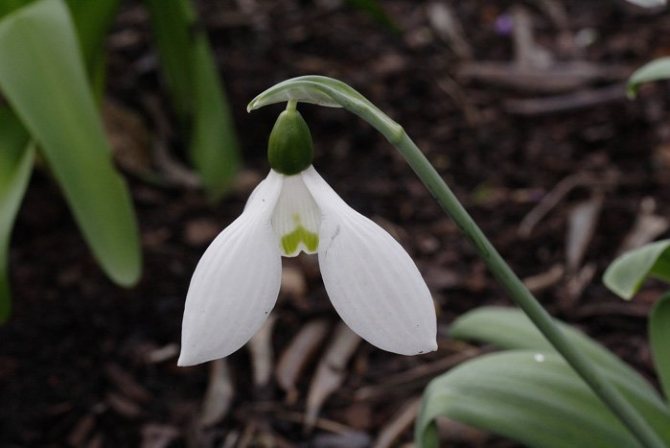

Important! Snowdrop bulbs are poisonous, so protective gloves should be worn when replanting this plant.
Dangerous and useful properties of galanthus
Snowdrop is not used in traditional medicine recipes because of its properties and the risk of poisoning. However, this plant has found its way into the medical industry. It is used to make potent medicines.


The attractive and delicate snowdrop contains alkaloids: galantamine and nivalin. They are used in medicine in the treatment of various serious pathologies: diseases of the nervous system, paralysis and complications of poliomyelitis. The alkaloid nivalin is used for migraines and seizures, absence of intestinal and urinary bladder motility. Medicines are poisonous and are used only as directed and prescribed by a doctor.
Snowdrop Bortkiewicz
Bortkevich's snowdrop (Galanthus bortkewitschianus) grows in the wild in the North Caucasus, preferring beech plantations. It got its name in honor of the dendrologist Bortkevich.
The bulb of the plant is about 30-40 mm long and 20-30 mm in diameter. Snowdrop leaves are deep green in color with a bluish tint, lanceolate, during the flowering period their length is 4-6 cm, but after, they grow up to 25-30 cm in length and up to 2 cm in width. The peduncle grows about 5-6 cm in height with a wing and pedicel of 3-4 cm.The flower of Bortkevich's snowdrop can be characterized by the following description: the outer leaves of the perianths are concave, inversely ovoid, about 15 mm long and 8-10 mm wide, with a depression at the apex and green coloring around the groove.


Growing features
It is better to buy bulbs and plant them in the period from July to September, at which time they are at rest. If the autumn is warm, then the planting can be moved until November.
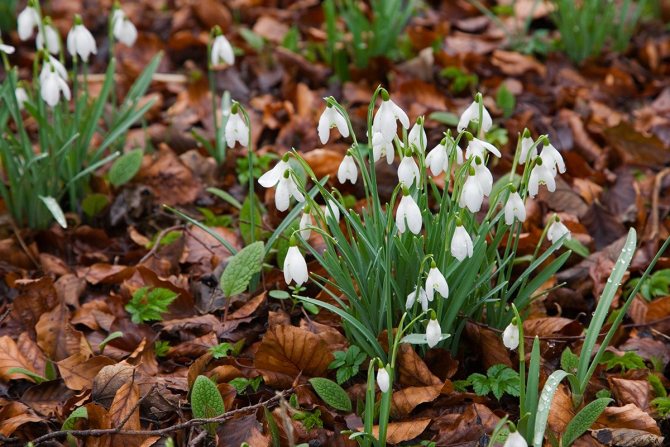

You should not buy plants with blossoming inflorescences, otherwise they will not survive after planting. In this case, the bulb will not die. Bloom in the near future will be sluggish or not bloom at all, but it will be alive.


When buying dormant bulbs, pay attention to their condition. Choose bulbs of a dense structure, weighty, with a whole shell, without stems and rhizomes, with an intact bottom, without mold, dents and deformations. If the bulbs are soft, then they are already rotting.
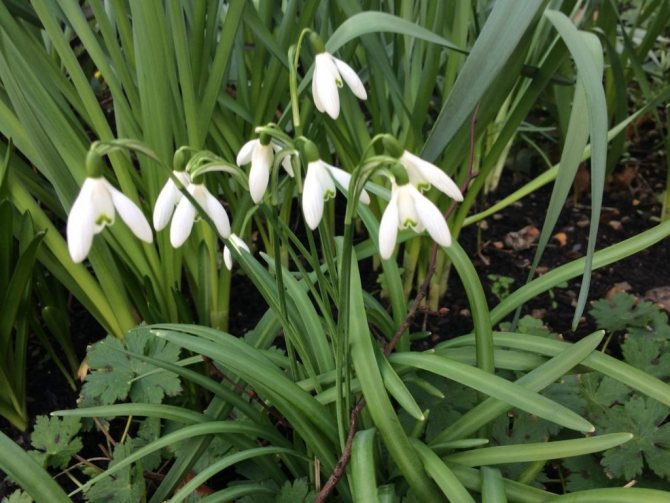

You should not store the bulbs of the plant for a long time, they can dry out, since they cannot stand being in the air for more than a month. In the absence of the possibility of timely planting, you need to place them in a perforated bag with sawdust or shavings. Their shelf life in this form will be 2-3 months.
When planting snowdrops, the soil is loosened and the bulbs are lowered into the ground by about 5 cm (at least). The flowers themselves will cope with the adjustment of the depth, since when the bulb is deeply located, they will release another one on the flower stem, thereby adjusting the size of the deepening.


But it is not at all necessary to observe a certain depth value. The only nuance of the shallow depth of the bulb is that the bulbs themselves will be smaller, but "babies" will quickly appear.
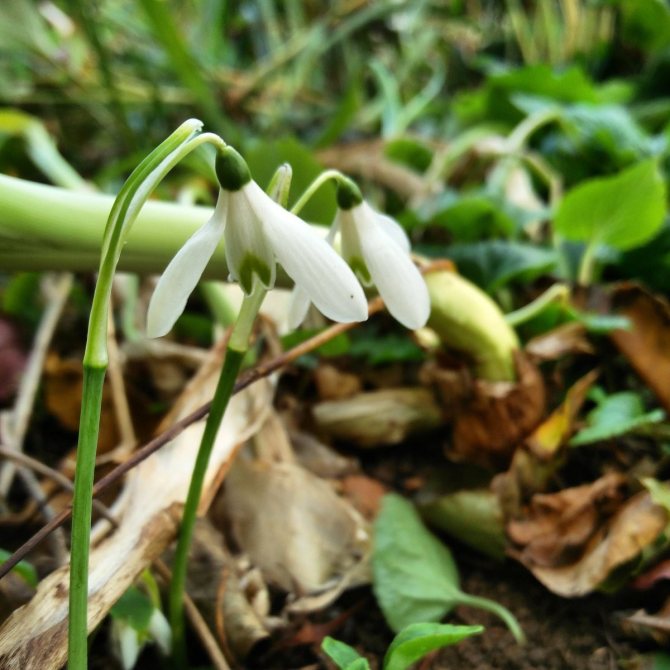

Snowdrops love shady, but warm places, lit by the sun and with excellent soil drainage. Resistant to low temperature conditions. The soil should be moist, loosened, nutritious and drained. A special irrigation regime is not required, except for periods of drought.
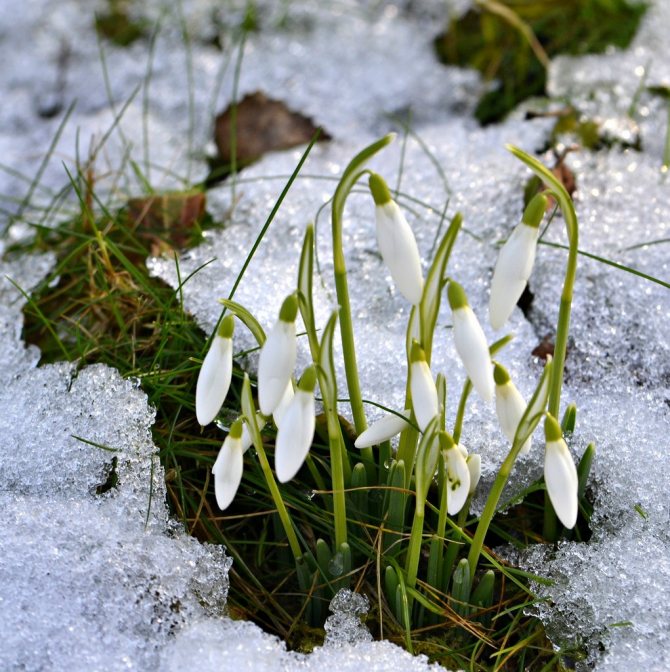

Snowdrop Krasnova
Snowdrop Krasnova (G. krasnovii) grows on the Black Sea coast of the Caucasus and Turkey, prefers beech, hornbeam and mixed forests. The flower got its name in honor of the botanist A. Krasnov.
The bulb of the plant is 20-35 mm long, 20-25 mm in diameter, and a bright green leaf during flowering reaches a length of 11-17 cm, and a width of about 2 cm, after flowering the leaves grow up to 25 cm. 15 cm, with a wing up to 4 cm long, with barely noticeable green keels.The outer tepals are slightly concave, 2-3 cm long and about 1 cm wide, the inner ones are elongated with a pointed end 10-15 cm long, about 5 mm wide.
Flowering occurs in early spring.


Plants of the Red Book
The forest snowdrop turned out to be a victim of human love, because after the harsh snowy winter, people hungry for greenery do not mind bringing home a bouquet of snowdrops and decorating their apartment with them. They are plucked completely in vain - by this time the forest snowdrop had just appeared, it has no particular appearance, since it has not bloomed yet, and these flowers do not last long - only a few days.
If the forest snowdrop used to grow in many countries, now there are extremely few Galanthuses left, because people, picking them to make a bouquet of snowdrops, also often spoil the bulb, completely rendering it unusable.
These plants are especially affected in early spring, during the spring holidays, when on March 8 women are presented with these delicate-looking flowers.
Forest snowdrop is listed in the Red Book as an endangered species, which means that it is prohibited to pick and collect it in the forest in order to form a bouquet of snowdrops. At the same time, as long as there is demand, there will always be supply, and therefore at the end of spring snowdrops plucked from the forest are sold in huge quantities on the streets and markets of both large and small cities.
When buying a forest snowdrop, you must always keep in mind that poachers thus receive a good income and a tangible incentive to find, dig up snowdrops in the snow next year and bring them to the city (they are not afraid of any fines provided for by law, because the benefit is still greater).
Snowdrop snow-white
Snowdrop snowdrop (Galanthus nivalis) the most common in our country, growing intensively, spreads over fairly large areas. The bulb is spherical, 10-20 mm in diameter. The leaves are flat, saturated green, about 10 cm long, the peduncles grow up to 12 cm high. The flowers are very large, up to 30 mm in diameter, have a green speck on the edge of the tepals. The outer tepals are elongated, the inner ones are much shorter, wedge-shaped.
Snow-white snowdrop blooms earlier than other species, and the flowering period lasts up to 25-30 days. This species has many varieties and varieties. Reproduction occurs both vegetatively and by seed, self-seeding is possible.


Broadleaf snowdrop
Broadleaf snowdrop (Galanthus plathyphyllus) has a large bulb up to 5 cm long, from which erect leaves grow of a rich green color, up to 16 cm long.A high peduncle (up to 20 cm) gives a large white bell-shaped flower, the outer petals of which are elliptical and cover shorter and more rounded internal. There is no indentation on the petals, but there is a noticeable green spot.
The broadleaf snowdrop blooms in late spring for 18-21 days. Fruits are not formed, the plant reproduces vegetatively. This species is common at the foot of the Alpine mountains, ideal for growing in our latitudes in fertile loose soil with sufficient lighting.


Did you know? It was noted that a longer and frosty winter also prolongs the duration of flowering of snowdrops in spring.
Diseases and pests
Of the pests, slugs, caterpillars of scoop butterflies, bulbous nematode attack Galanthus. From a nematode, a transplant will help. All diseased bulbs must be destroyed. Disinfect the rest by placing them in a manganese solution for several hours before transplanting.
He suffers from chlorosis and gray mold. Damp and warm weather can be the cause of fungal diseases. The affected parts must be cut off and the plant treated with fungicides. Chlorosis occurs from stagnant water in the soil. Good watering and good drainage will help here.
Folded snowdrop
Folded snowdrop (G. plicatus) is one of the tallest types of snowdrops with a rather large flower and characteristic curved leaf edges. In the wild, it grows in the mountainous territories of Ukraine, Romania and Moldova.
The bulb of the plant is ovoid, up to 30 mm in diameter, covered with scales of light colors. The leaves are pale green with a bluish tint, but after flowering, their color turns dark green. The peduncle grows up to 20-25 cm, and on it there is a single fragrant drooping flower, 25-30 mm long and up to 40 mm in diameter, which subsequently gives a fruit-box with seeds.
Flowering begins in March and lasts approximately 20 days. Reproduction - seed and bulbous. The folded snowdrop grows densely in the adjacent area, there can be up to 25 plants per 1 m², which bloom form a beautiful flower bed.
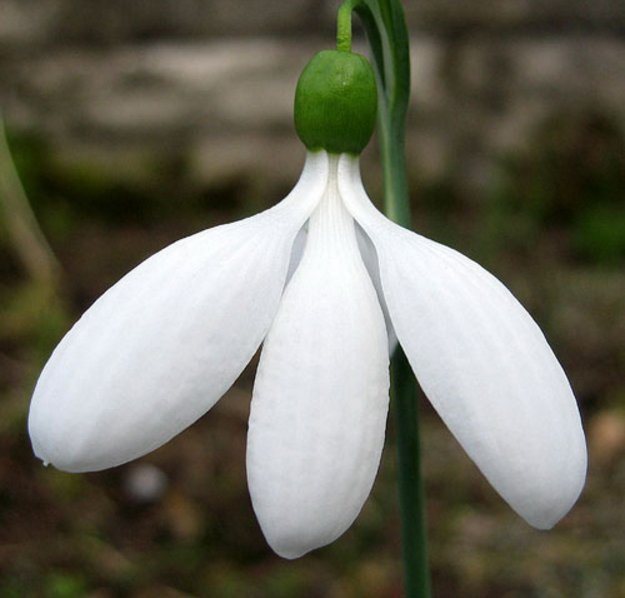

Snowdrop in legends and art
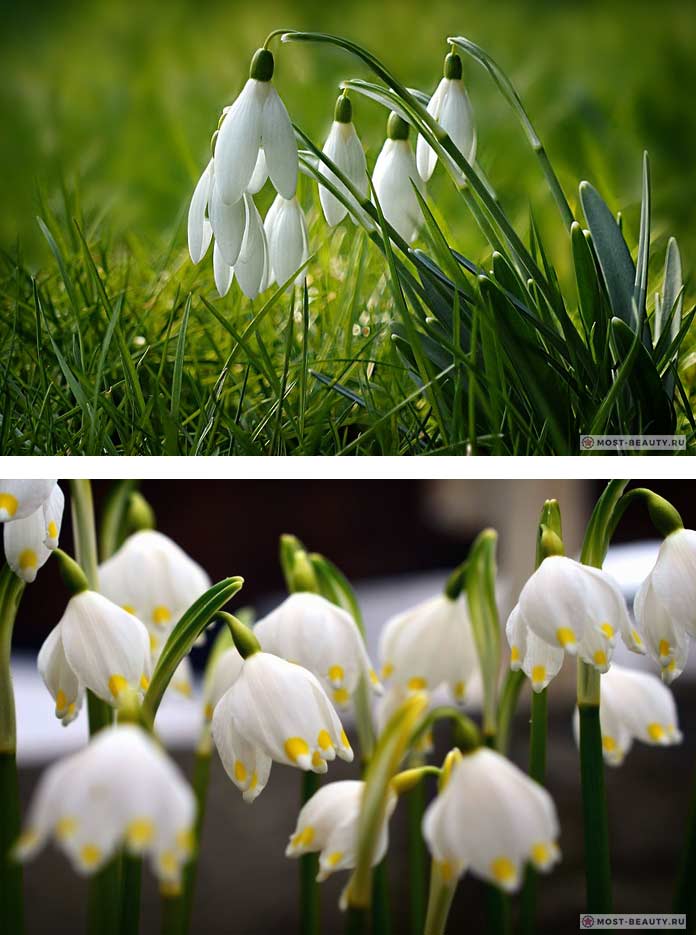

According to one of the legends, when Adam and Eve were expelled from Paradise, winter reigned on the earth. Several snowflakes have turned into miniature snow-white flowers to comfort them and show that spring is coming soon. Since then, it has been generally accepted that snowdrops symbolize hope.
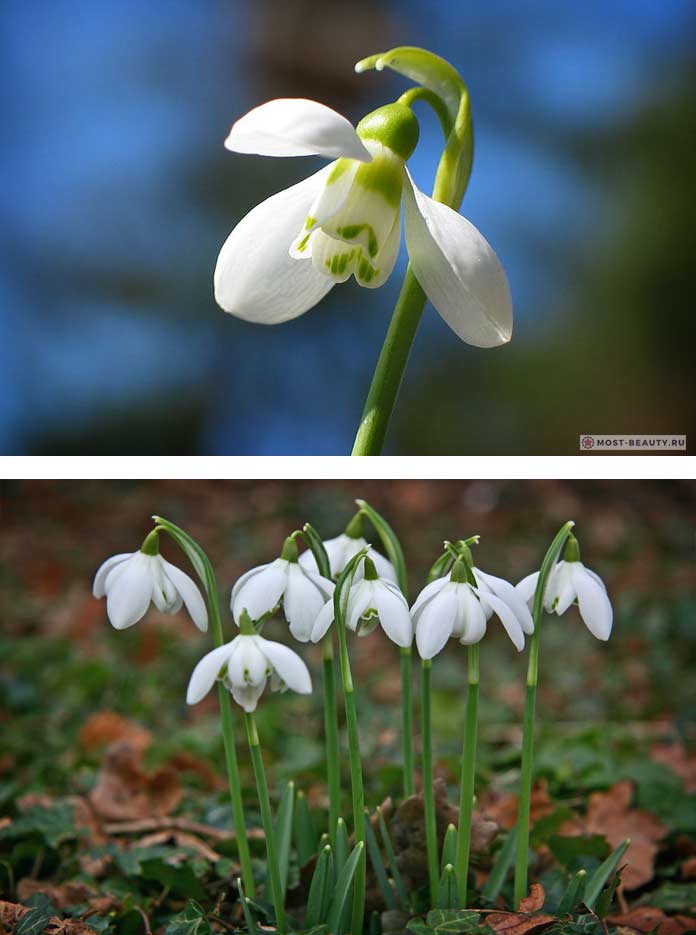

The French and Germans call this spring flower "snow bell" for the corresponding shape of the inflorescences, and the British call it "snow droplet". True fanatical collectors of varieties of this plant are called galanthophylls.


Many poems have been written about snowdrops, many artists were inspired by the beauty of these spring flowers, depicting them in paintings. For example, they can be seen in the paintings of the English impressionist Stephen Darbyshire, in the paintings of the Bosnian artist Dusan Vukovic, as well as in a number of works by contemporary artists. Songs are composed in which the role of this flower as the first messenger of spring awakening is noted. For example, a well-known line from the song "In the spring the snowdrop will bloom" sung by Ivan Kuchin.
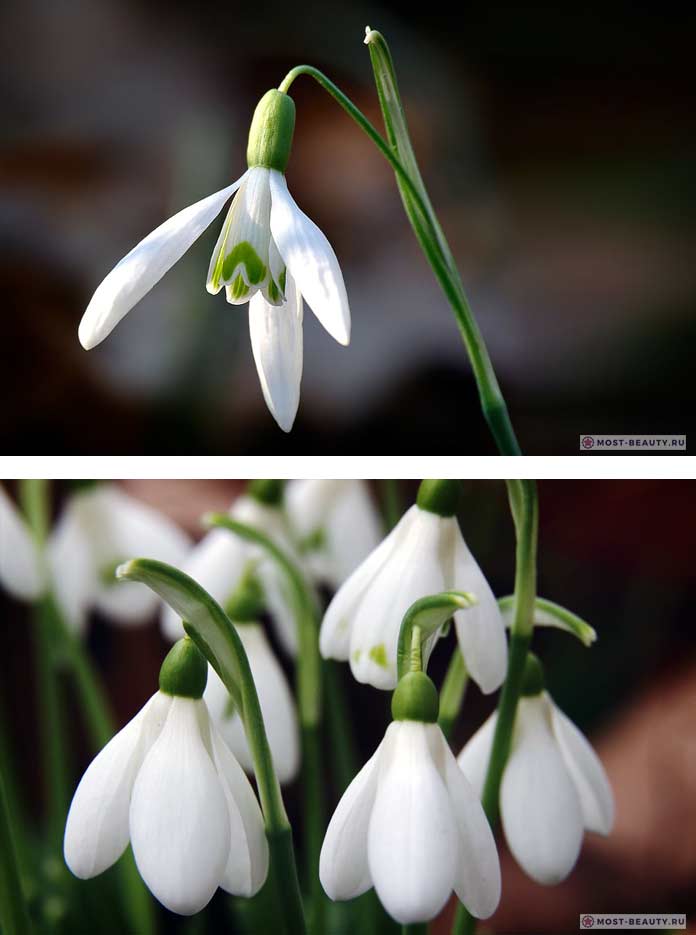

It is curious that the flower has its own holiday. In mid-April, on the 19th, Snowdrop Day is celebrated, dedicated to the preservation of a beautiful spring plant. It was invented by the British, who treat this flower with special trepidation. In their culture, it occupies a place similar to the tulip in Holland.
And on our website you can see a bright and colorful article about the most beautiful tulips in the world.
Snowdrop cilician
Cilician snowdrop (G. сilicicus) grows in the foothills of the mountains of Asia Minor and the Caucasus. The bulb is wedge-shaped, 15-23 mm long and up to 20 mm in diameter. Linear leaves are matte green, growing up to 15 cm in length and up to 1.5 cm in width. Peduncle is 14-16 cm long with a wing of 3 cm. The outer tepals are 19-22 mm long, elongated-oval, slightly tapering at the base, the inner ones are elongated, up to 10 mm long, have a depression at the apex with a partial green color.
Flowering occurs in mid-spring.
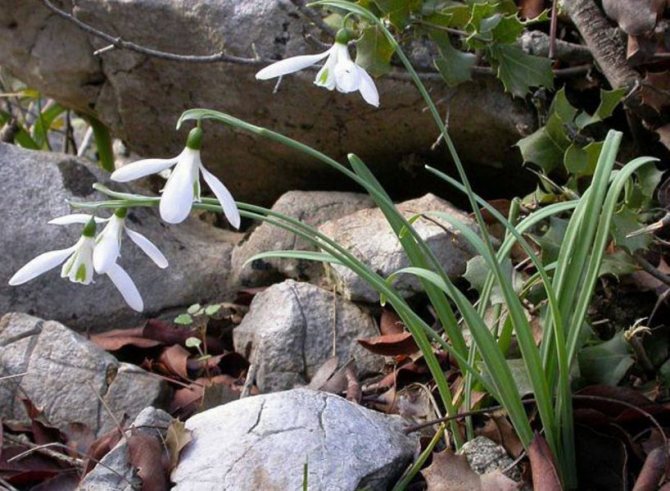

Home care
These flowers can be grown not only in the yard, but also at home - in a pot or in a bowl. The snowdrop, the very first of all bulbous flowers, to bloom, produces buds in the middle of winter. To do this, it must be taken out of the room.
Since we are talking about a very hardy and cold-loving plant that can survive at temperatures up to ten degrees below zero, it is not difficult to guess that it will die in a warm room. Therefore, during flowering, you need to keep the snowdrop in a very cold room.
Snowdrop Corfu
Corfu snowdrop (G. corcyrensis Stern) - got its name from its place of growth - the island of Corfu, also found in Sicily. Flowering occurs in late autumn, and a characteristic feature of this rare endangered snowdrop is the simultaneous appearance of leaves and flowers. This species is medium in size, with a rather large flower up to 25-30 mm long and 30-40 mm in diameter.The inner petals have a peculiar green pattern.


Popular message topics
- Dolmens of the Krasnodar Territory In this area there is where to roam and have something to see. Dolmens are one of the many attractions. These are such structures, similar to a stone table made of slabs, they are also carved into the rock. Their weight is not a single ton.
- Dobrynya Nikitich Dobrynya Nikitich is a hero of the Russian land. Dobrynya Nikitich possesses remarkable strength, he is courageous and courageous. This hero is mentioned in more than 50 stories. And at ten he is called,
- Relief wood carving Wood carving has been considered a traditional craft of many peoples for a very long time. And one of its types is relief carving. Accordingly, it got its name from the word - relief.
Snowdrop Elveza
Snowdrop Elveza (Galanthus elwesii) up to 25 cm high, grows in Eastern Europe, and is also cultivated there. Leaves up to 30 mm wide, bluish tint. Flowers - spherical large, their length reaches 5 cm, very fragrant. The inner tepals are marked with green spots.
Flowering begins at the end of winter and lasts up to 30 days.


Foster's Snowdrop
Foster's Snowdrop got its name in honor of the collector M. Foster. The snowdrop of this species grows in the territory of Western Asia, but the cultivation of flowers occurs in the countries of Western Europe. Flowering begins in early spring and lasts up to 15 days.
The leaves are narrow, lanceolate, up to 14 cm long, while the peduncle reaches a length of 10 cm. The flowers are medium in size. The outer tepals are concave, with characteristic green spots near the groove at the base, as well as at the apex of the inner leaf.
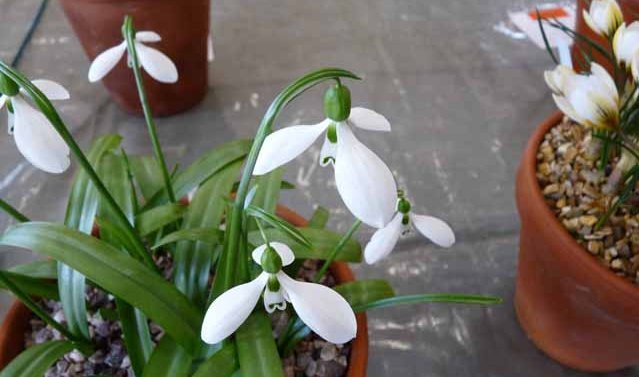

Snowdrop greek
Greek snowdrop (Galanthus graecus) grows in the forest foothills of Greece, Romania and Bulgaria.
The bulb of the plant is oblong, up to 15 mm long and up to 10 mm in diameter. The leaves are gray-green, up to 8 cm long and up to 8 mm wide, the leaf plate is wavy. The peduncle grows up to 8-9 cm, the wing is about 3 cm. The outer narrow leaves of the perianth reach 25 mm in length, the inner ones are half as large.
Flowering begins in April and lasts up to 15 days. Reproduction is vegetative.
Important! Snowdrop bulbs require prompt planting within 12-18 hours after digging, since outside the ground they quickly dry out and die.
Snowdrop icarian
Ikarian snowdrop (Galanthus ikariae Baker) grows on the rocky ground of the islands of Greece. In our country, it was not cultivated in the open field.
The bulb is 20-30 mm long and 15-25 mm in diameter, the leaves are dull green in color, up to 9 cm long before flowering and grow up to 20 cm after it. The peduncle reaches a height of up to 22 cm, the wing - 2.5-4 cm. The outer leaves of the perianths are concave, lanceolate, up to 25 mm long. The inner leaves are wedge-shaped, up to 12 mm long, have a green spot that occupies half of the leaf area. Flowering occurs in April.
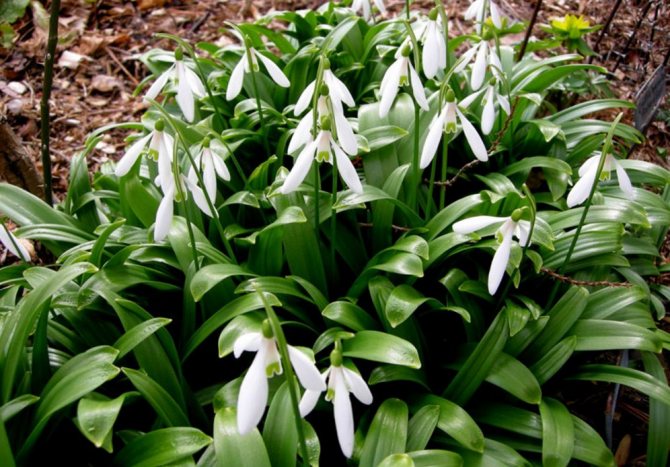

Reproduction methods
The most convenient way to propagate snowdrops is to separate the young bulbs. Each year, 1-3 additional bulbs are formed on the mother plant. After 3-5 years, when the curtain has grown enough, it can be divided. In August-September, after the foliage is completely dry, snowdrops can be transplanted. The bush is carefully separated by hands, being careful not to damage the thin rhizome. The bulbs are planted to a depth of 6-8 cm singly or in small groups.
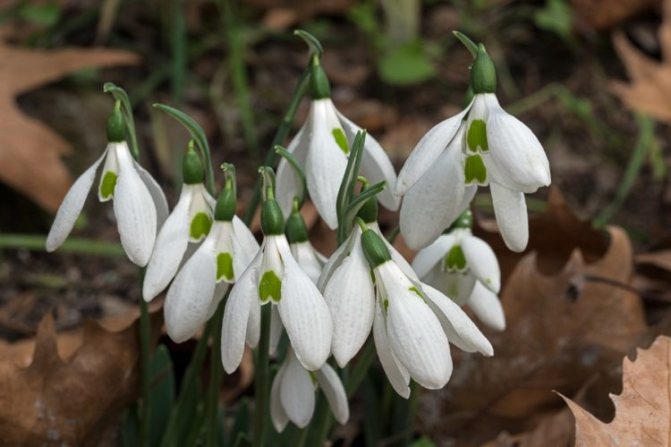

Seed propagation is considered more difficult, although it allows you to get many plants at once. It is necessary to allow the seeds to fully ripen. Crops are sown immediately after harvest, as they quickly lose their germination. Seeds are sown in open ground to a depth of 1-2 cm. Seedlings bloom in 3-4 years. The place should be chosen shady, windless.


